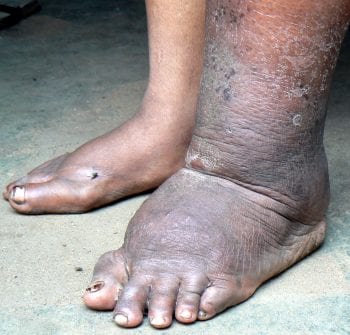Lymphatic filariasis (LF) is a deforming and disabling infectious disease that causes elephantiasis of the extremities and genital deformity (especially hydroceles in men). The Global Programme to Eliminate Lymphatic Filariasis (GPELF) aims to eliminate the disease by 2030. GPELF is the largest public health intervention for an infectious disease implemented to date based on mass treatment: 8.6 billion doses of antifilarial medications were distributed in endemic countries via mass drug administration (MDA) programs between 2000 and 2020. These treatments have cured tens of millions of infections, prevented tens of millions of cases of filarial disease, and reduced transmission. While GPELF has reduced the number of LF cases in the world by about half, approximately 800 million people remain at risk for the infection (mostly in Asia and Africa). Thus, despite significant progress, more time and better tools and strategies will be needed to achieve global LF elimination.
The DOLF project has conducted important community MDA and clinical trials on LF in recent years with endemic country colleagues in many countries. These studies have shown that:
- Semiannual (twice per year) MDA is no more effective than annual MDA if high treatment coverage can be achieved.
- MDA with albendazole alone is a viable strategy for LF elimination in areas where ivermectin cannot be safely used because of coendemic loiasis.
- Triple-drug treatment with ivermectin plus DEC and albendazole (IDA) is well tolerated and more effective for clearing filarial parasites from the blood than treatment with DEC plus albendazole; ongoing studies are exploring the value of other combination treatments for LF.
- Results from our studies suggest the need for revision of endpoint targets for LF elimination.
The parasite and the disease
LF is caused by threadlike nematode worms (species Wuchereria bancrofti, Brugia malayi and Brugia timori). Mosquitoes ingest a larval form of the parasite called microfilariae (approximately ¼ of a millimeter in length) when they feed on infected people. Microfilariae develop into third stage infective larvae (“L3”, about 1 mm long) in mosquitoes over a period of 2 weeks, and this stage initiates infections in humans when mosquitoes take their next blood meal. Thus, transmission requires a source of parasites in the human population and high biting rates of mosquitoes capable of transmitting the infection.
After transmission to humans, L3 develop over a period of 4 to 6 months into mature adult filarial worms that are several centimeters long. Adult worms live in lymphatic vessels and in lymph nodes. The adult female worms release microfilariae that move from the lymphatic system into the blood where they can be ingested by mosquitoes to complete the life cycle.
While many people with LF infections have no symptoms, damage to lymphatic vessels caused by filarial worms and inflammatory responses to the worms can lead to lymphedema with elephantiasis and to the acculumlation of fluid in the scrotum (known as hydrocele) of men who are infected. These conditions are disabling and associated with social stigma.
Learn more about Lymphatic Filariasis at the following sites:
Centers for Disease Control (CDC)
World Health Organization (WHO)
